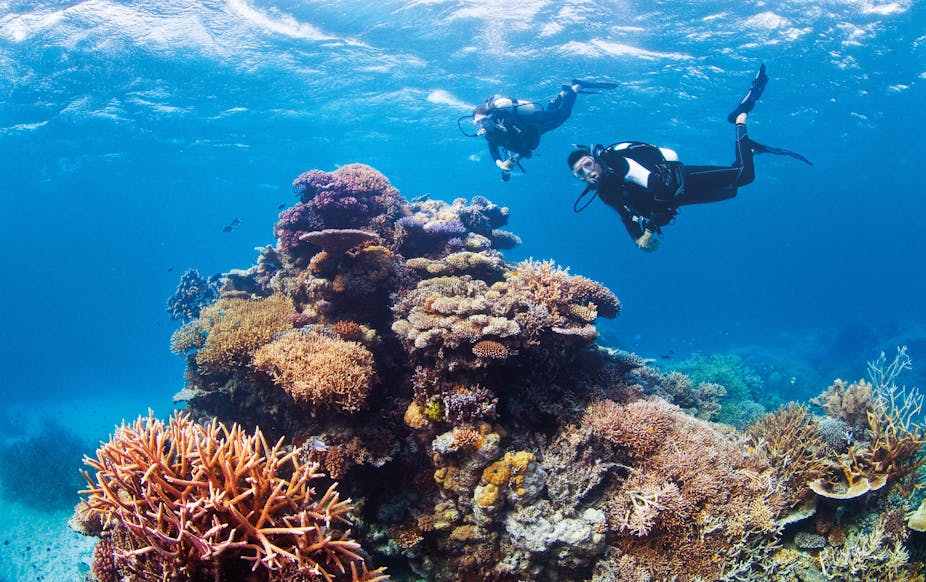UNESCO’s World Heritage Committee has decided not to add the Great Barrier Reef to the List of World Heritage in Danger, for now at least. In a draft decision released ahead of its annual meeting next month, it has welcomed Australia’s plan to save the Reef, but also demanded a progress report on its policies by the end of 2016, as well as a full update on the Reef’s conservation status by December 2019.
The move draws a temporary line underneath an issue that has loomed large for the past three years, bringing Australia’s stewardship of the Reef uncomfortably into the international spotlight.
During that time there has been copious input from scientists, politicians and campaigners, discussing threats such as climate change, dredging, pollution, shipping, and even the fate of the barramundi on our plates. It has got people talking all over the planet about whether or not the Australian and Queensland governments really care enough about one of the most recognisable symbols of Australia.
Not everyone has agreed with one another. As debated extensively on The Conversation and elsewhere, experts have advocated both for and against the idea of listing the Reef as endangered.
On one hand, the evidence is impossible to doubt that the Great Barrier Reef is in danger. Half of the corals on the Great Barrier Reef have disappeared since 1985, and the destruction of coastal habitat by rapid port development and other activities has been plain to see. On the other hand, the recent ramping up of remedies by both federal and state governments shows that our leaders clearly want to honour the promises made when the Great Barrier Reef was first listed as World Heritage in 1981.
Has UNESCO made the right call?
I have previously argued that a decision to list the Great Barrier Reef as endangered would be premature. So UNESCO’s decision makes a lot of sense to me, for several reasons.
The first is that the decline of the Great Barrier Reef began as much as 100 years ago, and hence is not something that the government can turn around overnight. It requires a concerted, non-political process that recognises and aggressively solves the problems of pollution, sediments, and unsustainable fishing.
Given that we have not had an effective process for some time (water quality, for instance, has been an issue for decades; it didn’t just pop up in the past couple of years), it would seem counterproductive to list the Great Barrier Reef as “in danger” at a time when federal and state governments are finally beginning to take clear actions in response to the issue. It will take time to rethink coastal agriculture, fix eroded gullies, and address issues such as coastal herbicide and pesticide use.
The second reason is that the response of ecosystems to these policy changes will necessarily be complex and slow. As coral populations hopefully rebound, seagrasses regrow, and threatened populations such as dugong being to recover, we will need to make careful long-term observations before we know if the actions taken now have been effective.
Short-term international manoeuvring won’t save the Great Barrier Reef. We need to think beyond politics and recognise that safeguarding the Reef will require a long-term commitment by Australia as a nation, not just a political process.
The third and final reason is that it would be rather perverse for UNESCO to ignore Australia’s clear intention to take this issue seriously. Given the effort that successive state and federal governments have made to avert an “in danger” listing, what incentive would remain if the listing was made anyway? It would hardly help to motivate future governments to fight the uphill battle of getting the listing removed again.
Crunch time
There is no doubt that federal environment minister Greg Hunt and his Queensland state counterpart Steven Miles will both be sighing with relief that the prospect of an “in danger” listing has been staved off for another five years. This is great for Australia and for the many people who believe that re-listing the reef as “in danger” would have been the wrong step to take at this time.
But the real work starts now. It’s time to vindicate UNESCO’s decision by showing that the Reef is truly being protected.
There are encouraging signs. The Queensland government has successfully introduced the Ports Bill, which restricts port development in Queensland to four so-called Priority Port Development Areas, and has restricted dredging for port facilities outside these areas for the next 10 years.
Meanwhile the federal government has banned port developers from dumping dredge spoil in the waters of the Great Barrier Reef, and both federal and state governments have committed to a long-term sustainability plan that acknowledges the major challenges from coastal development, pollution, and (in a somewhat less satisfactory way) climate change.
This is all well and good. But as pointed out before, the devil is in the detail. While still in process, much of these commitments still need to be legislated, and without legislation they are no more than hot air. We must also trust our science (and not private opinion), and ensure that we take real actions with a measurable outcome that safeguards the Reef.
It is also absolutely essential that loopholes, such as those within the Ports Bill, are removed so that we never again find ourselves engaging in activities that are ultimately at odds with the long-term future of the Great Barrier Reef. As it stands now, for example, the Ports Bill only prohibits “significant” port development. However, what is classified as “significant” is not defined by the Bill and is, at this point of time, entirely arbitrary. These problems need to be fixed if Australia’s apparent sincerity about solving the problems is to be believed.
Let’s hope that in 2020, when UNESCO assesses the progress that has been made, Australia passes with flying colours as a nation that has successfully turned around one of its most significant environmental problems.

